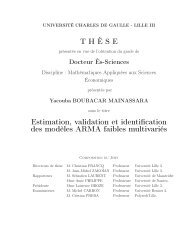A particle-in-Burgers model: theory and numerics - Laboratoire de ...
A particle-in-Burgers model: theory and numerics - Laboratoire de ...
A particle-in-Burgers model: theory and numerics - Laboratoire de ...
You also want an ePaper? Increase the reach of your titles
YUMPU automatically turns print PDFs into web optimized ePapers that Google loves.
Mo<strong>de</strong>l <strong>and</strong> motivation Auxiliary steps Results h = 0: coupl<strong>in</strong>g h = 0: <strong>de</strong>f<strong>in</strong>ition, uniqueness h = 0: <strong>numerics</strong>, existence The coupled problem<br />
Coupled problem: a well-balanced r<strong>and</strong>om-choice numerical scheme<br />
t<br />
t n+1<br />
t n<br />
x<br />
g0(u n In−1, u n In )<br />
u n+1<br />
In<br />
u n uIn n In<br />
ũ n+1<br />
In<br />
h n + v n ∆t<br />
h n + y<br />
gv n(un In ,ϕ− α(u n In+1))<br />
xIn−1/2 h n = xIn+1/2<br />
gv n(ϕ+ α(u n In ), un In+1)<br />
u n+1<br />
In+1<br />
u n In+1<br />
ũ n+1<br />
In+1<br />
g0(u n In , un In+1)<br />
h n+1<br />
xIn+3/2<br />
Figure: Representation of the algorithm based on the well-balanced scheme.
















